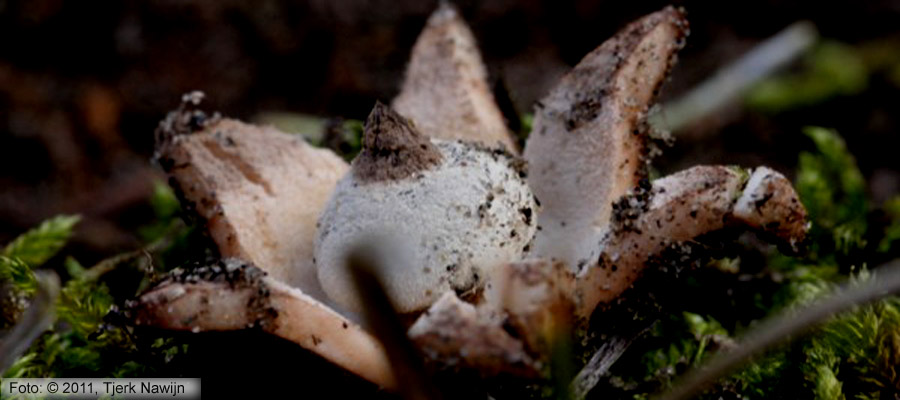
Photo: Striate Earthstar, Meijendel, October 21 2011
|
Striate Earthstar
(Geastrum striatum)
NMV Ga 211130
Striate Earthstar is a dunal earthstar in the Netherlands.
In the urban area this earthstar can be found in parks, gardens and dikes of roads, railroads, and metro, where dunal sand or sea-sand has been used as sand-suppletion.
Striate Earthstar can be found near Black Elder, Hawthorn, Common Spindle Tree, Ash, Elm, Oak, Pine, and Poplar.
IJburg and Gaasperpark are chances, and perhaps the bush near the metro-depot (Diemen).
A problem of the urban area is that poor dunal sand does not stay poor. Leaves are dropping on the sand, year after year after year.
And leaves of Ash, Elm or Poplar are very fertile. What was poor in 1990, is fertile now, so only
higher at the dikes you still can expect poor soil.
What is poor in 2012 (or poor dunal grassland), is just suppleted land, like the new islands of IJburg (Eastside of Amsterdam),
and the 10-15 yeats old recreation beaches along the lake Gooimeer, near the Hollandse brug (Muiderberg) and the Stichtse brug (Blaricum-Huizen).
These two highway-bridges are relative new, and the bridge-heads are build on dunal sand and clay.
The preferation for poor soil must be typical Dutch. In Scandinavia Striate Earthstar prefers relative more fertile soil.
Around 1999 Striate Earthstar was found in Bijlmerpark; nowadays the park has been replaces by houses.
Around 1999 Striate Earthstar was found near a sportpark (Amsterdam-North), and in the Amsterdamse bos
(both at places with dunal sand suppletion in 1967).
Striate Earthstar is developing some kind of chef's cap (or navy beret) while maturing, with under the balloon
a meaty cylinder as broad as the ballon, covering a stem. When drying the cylinder becomes a small ring, which sinks down to the star-rays.
What rests in the end, is a chef's cap on a stem. Drying (or finding an old earthstar in the direct neighboorhood) is a must to inspect stem and apophyse.
There are mycologists knowing dunal earthstars so well that they even recognise earthstar species just born or almost worn.
About the photo's Tjerk Nawijn wrote: "Without the help of Luc Knijnsberg it was not possible to name the right species;
I'm gratefull for what he did.".
|
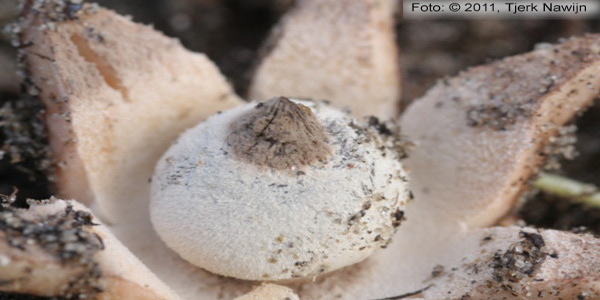
Photo: Striate Earthstar, Meijendel, October 21 2011 |
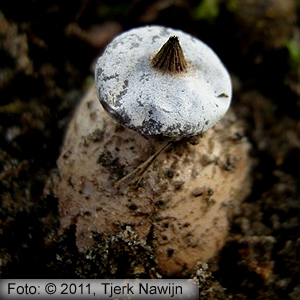
Photo: Striate Earthstar, Meijendel, October 21 2011 |
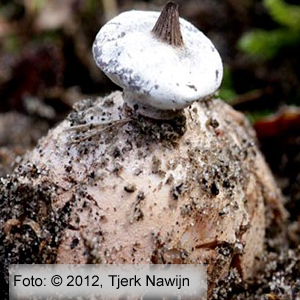
Photo: Meijendel, October 21 2011 |
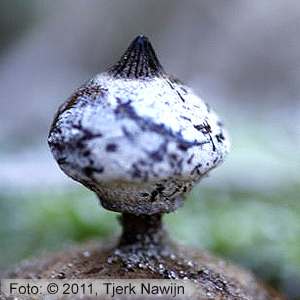
Photo: Meijendel, January 16 2012 |
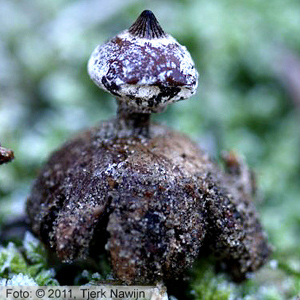
Photo: Meijendel, January 16 2012 |
Mistakability:
Striate Earthstar has been seen in the past in the urban Amsterdam area, and the best chance to find back
is to know how this earthstar looks like, where this earthstar could be found, and what species are mistakable.
Older and more mature Beaked Earthstar is the best candidate for a wrong name.
How about the just born species ? Duhno ...
|
How to exclude mistakability:
- Encrusted debris ?
- Meaty cylinder ?
- Stem ?
- Apophyse, what shape ??
- If this is not helpful: dry the earthstar, and see what changes during the dry-process
|
|
Field-marks: See: Anatomy Genus Geastrum
Striate Earthstar field-marks:
- Species size: small to medium
- Stem (below balloon): short to long (2-7 mm), broad (1-6 mm), sometimes oval-shaped
- Stem color: brownish
- Balloon in diameter: 8-19 mm
- Balloon surface young: floury layer of cristalline grains (sometimes temporary, sometimes permanent)
- Balloon surface older: dark tints of grey, brown, or black-blueish (slate)
- Balloon color: young light-brown
- Balloon color: older often lead-grey polished, sometimes copper-brown
- Balloon mouth-zone: high conical plicate-furrowy, no court, sometimes sharp ring-furrow
- Star-rays number: 6-11
- Star-rays-thickness: fresh upto 5 mm.
- Star-rays-color young: light-creme
- Star-rays-color older: brown
- Star-rays:
- Star-rays: non-hygroscopic
- Star-rays: encrusted debris (disappearing at old age)
|
Habitat:
In forests and wood, coastal dunes, river dunes, road-sides, sandy parks and gardens.
As well in calcareous as well as in calcareous-poor areas.
|
Regional:
Urban Amsterdam area: 6 square kilometers until 1999 (including Amsterdamse bos, Bijlmerpark, Amsterdam-North)
Pleistocene area: no.
Northsea dunal area: in calcareous and calcareous-poor dunes
|
Wood species:
Deciduous (Ash, Black Elder, Elm, Hawthorn, Oak, Poplar)
Coniferous (pine)
|
Literature:
Chrispijn, R. ed. (1999), Champignons in de Jordaan (De paddenstoelen van Amsterdam), Schuyt en Co, 162-163.
Hansen L. & H. Knudsen (1997), Nordic Macromycetes, Vol. 3, Heterobasidioid, aphyllophoroid and gasteromycetoid basidiomycetes, Kopenhagen, 1997, 444 pp.
Jalink, Leo M (1995) De aardsterren van Nederland en België, Coolia 38 Supplement.
www.mycobank.com
|
Top
|